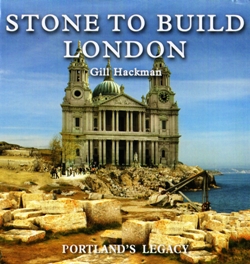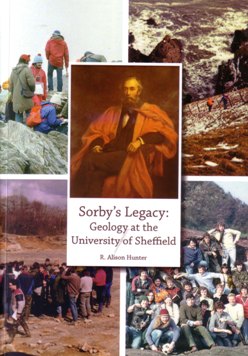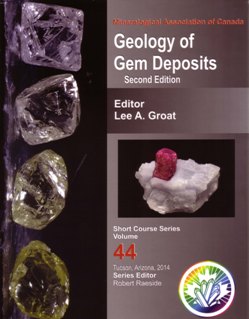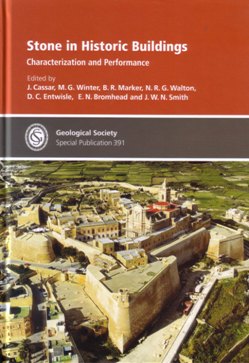
Stone to Build London
As a geologist who studied and worked in various Portland Stone buildings on both banks of the Thames, this book is a delight!
In the 1950s the author sat at her Granny’s knee to hear tell that “Portland is a special place because it is a Royal Manor and belongs to the Queen”. Granny told of her Portland ancestors and the quarrying trade that has existed, on and off, since Roman times and with London since 1350.
This is a lavishly illustrated book with 325 photos (over 75% colour) and 35 maps and diagrams. It should appeal to geologists, archaeologists, historians, building engineers and architects alike.
Part One is a brief overview, followed by Part Two (nine chapters) which cover the history of quarrying and the use of Portland Stone in London and the Empire from 1600 onwards. Part Three comprises a tour of 135 of London’s Portland Stone buildings and monuments with seven maps and 111 colour photos. For visitors to this isolated corner of Dorset, there follows a guide with a map and 16 colour photos. Five Appendices cover the geology, quarrying methods, exports and examples beyond London: UK, Eire, Belgium, Denmark, Japan and the USA (e.g. the Mason-Dixon monument 1751). This book reveals the history of The Isle of Portland, not only the quarrying and stone export but its interlinked land ownership and agricultural history.
There are some fascinating gems about quarrying on the Royal Manor and the use of the stone in London, especially since 1600 – in particular the impact of London’s economic and political history on the development of the Portland stone industry. Local personalities have played a fascinating role, especially in the 18th Century. Links with London scientists are mentioned, e.g. ‘The father of modern science’ Robert Hooke, who concluded in 1665 that fossilised objects like petrified wood and fossil shells, such as ammonites, were the remains of living things, a conclusion praised by Charles Lyell in his Principles of Geology (1832).
I have often been surprised that so many buildings and memorials (e.g. war graves) could have come from such a small Dorset island but Gill’s maps reveal the extent of quarrying over the years, from coastal landslips to inland quarries and nowadays, adit mining. I estimate that quarrying has taken place over some 3.5 km2.
Geologist, the Rev. Townsend (1813) listed the Portland Stone as the ‘Superior Oolite’ – he was right in every sense!
Reviewed by Geoff Townson
STONE TO BUILD LONDON – PORTLAND’S LEGACY by Gill Hackman, 2014. Published by: Folly Books Ltd; 320pp (hbk 250 x 250mm). ISBN: 978 0 9564405 9 4; List Price: £24.99. W: www.bradford-on-avon.org.uk

Sorby's Legacy: Geology at the University of Sheffield
This well written and most interesting record of the formation, expansion and sad demise of the very well-regarded Sheffield Geology Department, was written by a member of the 1971 Honours class. It details the staff and is excellently illustrated with photographs of members, premises, field excursions and laboratory classes.
Although geology was part of the metallurgy curriculum in Sheffield before the 1905 formation of the University, a Geology Department did not appear until 1913, being the result of a legacy left by Henry Clifton Sorby FRS (1826−1908), the brilliant Sheffield petrologist, and the ‘Father of Microscopical Petrography’.
The first Sorby Professor was William G Fearnsides (1879−1968), but the day student total did not reach 10 until 1919 when an Honours School of Geology was established. Even so, the total day students each year, including metallurgists, engineers and science students, was ~20−35 after the post 1914−18 war bulge until 1939, with only three to seven Honours students. Fearnsides retired in 1945 and Frederick W Shotton was appointed to the Chair.
Shotton had to cope with enormously increased student numbers in very inadequate accommodation and he resigned in 1949 to be replaced by the dynamic and much loved Leslie R Moore (1912−2003). Moore expanded the Department to one of the largest in the country, appointed staff who became distinguished, initiated fossil palynology studies which led to the Department’s becoming the national centre for this work, with ~250 postgraduates being trained - and eagerly snapped up by employers. Expeditions to Kilimanjaro, the Sahara, North Peary Land and Iceland added to the Department’s success.
But the 1949 promise to Moore of a new departmental building was never fulfilled and his successor in the Sorby Chair from 1978, J Barry Dawson faced a split site and a lack of top University support, which in 1987 slashed income by 53% to preserve resources for chemistry and physics. This triggered downgrading in the Oxburgh Review; the Department closed in 1990 to be partly replaced by a small Earth Science Unit (within Animal and Plant Sciences) which itself was closed in 2001. Palynological work continues as a Centre under Professor Charles Wellman in Animal and Plant Sciences, and the proceeds of this book go towards supporting this work.
A superb Department closed by an inept hierarchy.
Reviewed by Bernard Elgey Leake
SORBY’S LEGACY: GEOLOGY AT THE UNIVERSITY OF SHEFFIELD. R Alison Hunter, author and publisher, 2013, 201pp. Details at www.geologyatsheffield.co.uk

Geology of Gem Deposits
Gemmology is an evolving science in which increasingly complex analytical techniques are used to confirm provenance and identity of valuable gemstones. Gemmologists are generally less interested in the origin and paragenesis of gemstones as in testing and classifying them.
For the geologist, particularly the mineralogist, they form an intriguing subset of the mineral kingdom. Gemstones may have a metamorphic or igneous origin, and/or develop along some kind of diffusion couplet. Understanding their paragenesis involves a combination of mineral chemistry, and aspects of fluid, metamorphic and magmatic processes.
This second edition of Geology of Gem Deposits arises out of a Mineralogical Association of Canada short course held at Tucson in 2014 and supersedes an earlier volume published in 2007. The format is much the same as the first volume. An opening chapter on diamond is followed by chapters on gem corundum deposits (including ruby and sapphire), emerald, non-emerald beryl, chrysoberyl, tsavorite and tanzanite, topaz, gem-bearing pegmatites, and jade (jadeite jade and nephrite jade). A general discussion on the geology of gems and their geographic origin separates the chapters on corundum and emerald.
The volume closes with an overview of Canadian Coloured Gemstones supported by nine pages of colour images. The book runs to 393 pages with some chapters greatly increased in length, including that on corundum (now 84 pages long) and that on tsavorite and tanzanite. Most of the diagrams are the same, although many have been rendered into colour, making the volume more visually attractive. Another enhancement is that colour images of gemstones and gem bearing rocks have been embedded into the text rather than being included in a series of separate colour pages, giving them added immediacy.
For anybody interested in gemstones from a geological perspective, this is a wonderful book. All the authors are well known in their field, although I note that in the index not all chapters have authors attributed to them. Scientifically up to date, well put together and illustrated with appropriate use of colour, this is an attractive book to dip into. If I have a pedantic quibble it is that there is no consistent format between chapters. Each is written as a stand-alone paper so geology and geography are dealt with in different ways.
My main disappointment is in the section ‘Geology of Gems and their Geographical Origin’. This could have been a major statement but ends up being rather bland and uncontroversial.
Reviewed by Peter Treolar
GEOLOGY OF GEM DEPOSITS (2nd edition). Groat, L E (Ed) 2014. Mineralogical Association of Canada, Short Course Series Volume 44. 405 pp. ISBN 978-0-921294-54-2

Stone in Historic Buildings
For millennia stone has been exploited for building, architectural use, decoration and ornamentation. Where did suitable stone occur? What were its geological characteristics and context? What were its technical and aesthetic properties? Were transport communications good? How costly was the stone? Did the stone have cultural significance in being emblematic of the district or region of its exploitation? Have problems of building conservation arisen because the original quarries fell out of use or disappeared and was an acceptable replacement stone hard to find?
These are among the questions addressed in this Special Publication of the Geological Society, edited by a team led by J Cassar (University of Malta), a worthy successor to the Society’s previous Special Publications 205, 271, 331, 333 and 391 (see also the Geological society of America’s Special Paper 390).
Three papers cover availability. Bristow reviews stone in Cornwall, and especially the granites. From West Sussex, Cordiner records an extraordinary 52 lithologies to be found in the County’s 180 late medieval to modern churches, noting a strong geographical control on distribution. Turning to Tuscany, Fratini and Rescic review the complicated igneous, sedimentary and metamorphic rocks of this region, their use in historic buildings, and the subsequent problems of conservation.
The thrust of two technical papers, both by Calia and others, is on the characterisation of stone from the standpoint of the Italian conservator: the porous calcarenite called pietra gentile in Puglia, and the calcarenite known as Lecce stone used in the Salento region.
Many buildings and settlements present problems of conservation and restoration. The restoration of buildings of Lede stone in Belgium (de Kock et al.) and of Reims Cathedral in northeast France (Turmel et al.) is proving difficult because the limestones originally used are no longer available. The buildings and monuments of Salamanca in central Spain – a UNESCO World Heritage Site – exploited a wide range of materials, not all of which are now available (Peirera and Cooper). André et al. explore the benefits and disadvantages of different pointing mortars used to conserve Romanesque churches in the French Massif Central. The odd-man-out in this collection is the paper by Laycock and Wood describing laboratory experiments on the penetration of rain into masonry.
The production standard is high, except for most of the illustrations of thin-sections, which are too small to be of real use. A map of Spain would have helped the reader unfamiliar with the whereabouts of Salamanca.
Reviewed by J R L Allen
STONE IN HISTORIC BUILDINGS - CHARACTERIZATION AND PERFORMANCE: J Cassar et al. (Eds). 2014. Published by: Geological Society, London, Special Publications. 391. 200 pp. ISBN 978-1-86239-376-9. List price: £90.00; Fellows' price: £45.00; Other societies' price: £54.00